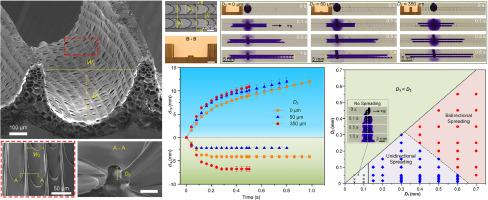Enhancing spontaneous and continuous liquid directional transport on peristome-mimetic surface with hierarchical microgrooves
IF 8.3
2区 材料科学
Q1 MATERIALS SCIENCE, MULTIDISCIPLINARY
引用次数: 0
Abstract
Directional liquid transport function discovered on the peristome of Nepenthes alata has attracted considerable attention for its diverse potential applications. Despite the extensive efforts made for the peristome-mimetic surface fabrication and the anisotropic liquid spreading regulation, it remains a daunting challenge to reveal the synergistic effect of hierarchical structures on the liquid spreading and pinning dynamics. Here, we demonstrate the first-tier microgroove morphology, as well as the presence of second-tier microgrooves, play an important role in homogenous film formation and the directional liquid transport control. Through experimental investigation and theoretical analysis, the enhanced spreading and pinning effect is validated. Moreover, the preferential directional liquid spreading will collapse on the peristome-mimetic surface without a rational parameter design, and the threshold value for the transition of liquid propagation dynamics is determined. Spontaneous directional liquid transport from the cold region to the hot region and smart liquid transport regulation was also realized on the peristome-mimetic surface. This work will provide guidance to the design of effective open microfluidic systems, and open a new way for thermal management and lab-on-chip applications.

在具有分层微槽的仿蠕动体表面上增强自发和连续的液体定向传输
在尼泊尔胡颓子(Nepenthes alata)围体上发现的定向液体传输功能因其多种潜在应用而备受关注。尽管在仿生包膜表面制造和各向异性液体铺展调节方面做出了大量努力,但要揭示分层结构对液体铺展和钉扎动力学的协同效应仍是一项艰巨的挑战。在此,我们证明了第一层微凹槽形态以及第二层微凹槽的存在在均质薄膜形成和定向液体传输控制中的重要作用。通过实验研究和理论分析,增强的铺展和针刺效应得到了验证。此外,在没有合理参数设计的情况下,液体优先定向扩散会在周室模拟表面上崩溃,并确定了液体传播动力学转变的临界值。在仿活塞表面上还实现了液体从冷区向热区的自发定向传输和智能液体传输调节。这项工作将为设计有效的开放式微流控系统提供指导,并为热管理和片上实验室应用开辟一条新途径。
本文章由计算机程序翻译,如有差异,请以英文原文为准。
求助全文
约1分钟内获得全文
求助全文
来源期刊

ACS Applied Materials & Interfaces
工程技术-材料科学:综合
CiteScore
16.00
自引率
6.30%
发文量
4978
审稿时长
1.8 months
期刊介绍:
ACS Applied Materials & Interfaces is a leading interdisciplinary journal that brings together chemists, engineers, physicists, and biologists to explore the development and utilization of newly-discovered materials and interfacial processes for specific applications. Our journal has experienced remarkable growth since its establishment in 2009, both in terms of the number of articles published and the impact of the research showcased. We are proud to foster a truly global community, with the majority of published articles originating from outside the United States, reflecting the rapid growth of applied research worldwide.
 求助内容:
求助内容: 应助结果提醒方式:
应助结果提醒方式:


